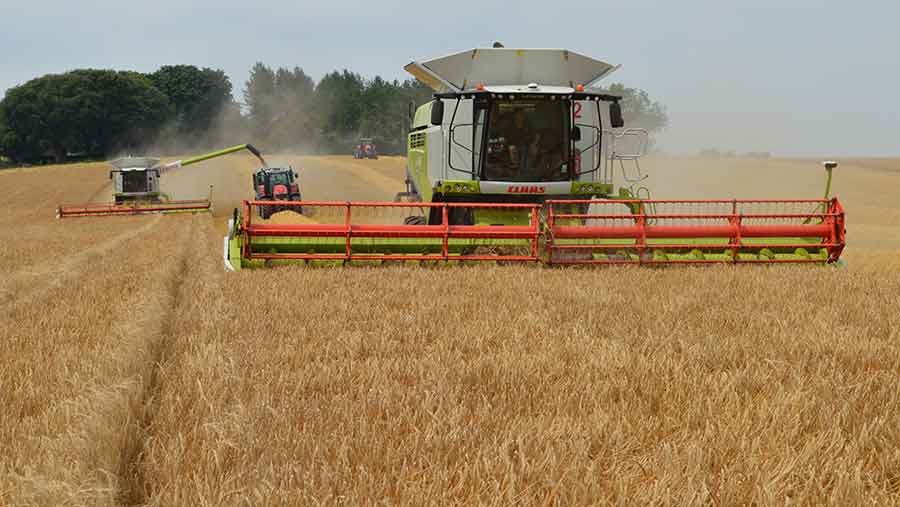Harvest 2016: Quality and yield worries as combines roll on

Poor quality and yields are starting to emerge as harvest progresses slowly across south and central England with crops having suffered from a mild winter followed by a wet and dull June.
Hampshire grower Daniel Crawford says he plans to start combining 110ha of winter barley at Neatham Farm, Alton, Hampshire, next week – later than usual because of poor weather in June.
While 30ha of the new six-row winter barley variety Bazooka looks promising, his 80ha of Glacier has suffered from blackgrass problems and has been held back by the weather.
See also: Harvest 2016: Freak hail storm decimates OSR and wheat crops
The gloomy conditions in early summer also meant 250ha of his Harper oilseed rape has not quite matured, with moisture content at about 7%, slightly above the 6% target.
Mr Crawford is more optimistic about his 300ha of Propino and Explorer spring barley, which was direct drilled and is looking good.
Elsewhere on the farm, 300ha of Crusoe winter wheat, 160ha of Fuego spring beans and Canyon spring oats had all fared well through the season.
Progress in Essex
Some progress had been made in Essex, where Andrew Kerr started combining on Wednesday (20 July) at Newhouse Farm, North Weald. But the first 21ha of Volume winter barley has been disappointing, with yields peaking at 6.25t/ha and specific weights at 62-65kg/hl.
“We are normally over the 7.4t/ha mark and the only bonus we have is that the crop won’t need drying as moisture contents are low at 11.6-14.9%,” says Mr Kerr.
He reckons the damage was done in the mild winter which allowed diseases to get a foothold. An unusually wet June for Essex compounded the problems, with 153mm of rain falling.
“Winter wheat crops of Reflection and Crusoe are looking okay but have fusarium in the ears. We carried out comprehensive T3 and T4 sprays but the conditions were perfect for disease,” says Mr Kerr.
Slow going in Cornwall
It was a similar picture in the far south-west of England for John Moss, a grower and contractor based at Howton Farm, Pillaton, Cornwall, where progress has been slow, with just 132ha combined out of the 1,200ha of crops he has to cut.
“We started combining Tower barley on Tuesday [19 July]. It is a later start because it has been wet every day here,” he says.
Initial yields were averaging 5-6.25t/ha and moisture contents were between 14% and 16%.
“Crops are thin, allowing blackgrass to come through and there has been a high level of BYDV in some areas of the county. Aphid damage is bad and some crops haven’t had a hope in hell’s chance,” he adds.
In the Midlands, Roger Brian began harvest on 20 July with 15ha of Advance oilseed rape now cut. Yields have been lower than normal at about 3.4t/ha and moisture was at 5.9%.
But he says 20ha of Osprey, which is still to cut, looks much better and he is optimistic of good yields.
Mr Brian is concerned about his Crusoe winter wheat, which is looking thin. “Growing conditions have been bad. We have had a wet winter and a lot of rain in the early part of the summer,” he says.
However, his two other winter wheat varieties, Claire and Leeds, had fared better, he adds.
Making a start in Cambridgeshire
Further east in Cambridgeshire, Stephan Ellerbeck is holding his breath ahead of combining at Highfield Farm, Huntingdon, today (22 July) with harvest 2016 difficult to predict.
Winter wheats – Skyfall, Lili and Trinity – had a lot of disease and weed pressure.
“Yields look likely to be average for the winter crops. It’s a combination of the chemistry not controlling the blackgrass and the mild, wet weather causing disease,” he says.
But Mulika spring wheat was looking promising. “It didn’t have to endure the winter which allowed the blackgrass to get ahead,” he adds.

